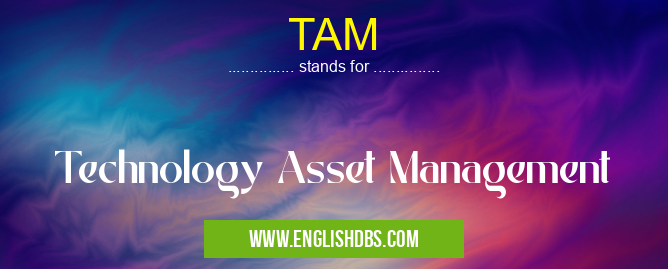What does TAM mean in TECHNOLOGY
Technology Asset Management (TAM) is a comprehensive system that enables organizations to monitor, manage and maintain all the assets associated with their IT infrastructure. This includes hardware, software, networking components, processes and data. TAM helps to ensure the availability of critical IT resources for meeting business objectives and reducing operational costs.

TAM meaning in Technology in Computing
TAM mostly used in an acronym Technology in Category Computing that means Technology Asset Management
Shorthand: TAM,
Full Form: Technology Asset Management
For more information of "Technology Asset Management", see the section below.
» Computing » Technology
Essential Questions and Answers on Technology Asset Management in "COMPUTING»TECHNOLOGY"
What is Technology Asset Management?
What are the Benefits of Technology Asset Management?
The main benefits of TAM are improved efficiency in IT asset management operations, improved decision-making capabilities due to better visibility into IT assets and usage trends, increased security by enforcing compliance with industry regulations, better data accuracy for reporting purposes, lower total cost of ownership through optimized purchasing decisions and proactive maintenance scheduling.
How Does Technology Asset Management Work?
TAM uses an integrated set of processes and tools to monitor, manage, support and maintain all technology assets in an organization's IT environment. It includes asset inventory tracking which records physical and logical properties such as manufacturer information and version details; asset lifecycle management which tracks changes in ownership or license type across different stages in the asset's life; asset configuration tracking which stores custom settings applied to hardware or software; change management processes which track any changes made; patch management to keep systems up-to-date with fixes or updates; and reporting capabilities to analyze usage trends or costs incurred.
What Are the Components of a Technology Asset Management System?
A TAM system typically consists of an enterprise asset database which stores information about all hardware/software assets within an organization as well as relevant business rules; a discovery engine which identifies new assets on an ongoing basis; patching/configuration control mechanisms for keeping track of software license information along with any custom configurations applied; reporting capabilities such as dashboards for real-time insights into asset utilization trends or costs incurred for specific periods; alert functions for proactively notifying administrators when certain thresholds are reached or breached; security features such as identity management protocols to protect sensitive data from unauthorized access; and API services for integrating with existing third-party applications.
How Can Organizations Leverage Technology Asset Management Program?
By leveraging TAM programs organizations can gain greater visibility into their IT infrastructure thereby gaining deeper insights into how their technology assets are being utilized. This can help them optimize their budgeting efforts by pinpointing redundant resources or determining where additional investments should be made. Additionally, they can enforce compliance with industry regulations more effectively while minimizing downtime through proactive patch management or configuration control measures. Furthermore organizations can reduce risks associated loss or theft since they always have up-to-date records at hand whenever necessary.
What Skill Sets Are Required For Successful Implementation Of Technology Assets Management System?
Implementing effective TAM systems requires a combination of technical knowledge combined with business understanding as well as project management skills. On the technical side knowing how to configure servers, networks systems etc is essential whereas on the business side it's important to have knowledge about accounting principles related to finance & budgeting as well as applicable laws governing technology procurement & use within your region etc. Lastly having good project management skills will ensure successful implementation & deployment across various departments within an organization in addition monitoring progress & providing appropriate feedback loops throughout each phase accordingly.
What Are The Challenges Involved In Managing Technology Assets?
One challenge lies in accurately cataloguing all hardware/software resources available within an organization while keeping track of complex interconnections between various components thereof through periodic audits & reviewing status reports generated using embedded governance models therein. Additionally ensuring consistent levels of performance throughout upgradation cycles is often difficult because it involves multiple stakeholders operating at diverse geographical locations having different technical expertise levels amongst them thus necessitating accurate coordination & communication throughout each stage. Lastly staying up-to date regarding availability/integration technologies released by manufacturers regularly so that organizations remain competitively ahead vis-a-vis their peers.[END]
Q :What Types Of Reports Does A Typical Technology Asset Management System Generate?
A :Depending on requirements typically TAM systems generate reports related to inventory,usage,cost details, compliance status, audit results etc along with dashboards allowing real time visualization so that decision makers can quickly assess current situation & act accordingly if needed. Additionally some systems come pre integrated with predictive analytics capabilities allowing assessment regarding future needs & potential challenges based on past behaviour analysis etc.[END]
Q :How Can We Ensure That Data Stored Within Our Tech Asset Database Is Secure?
A :Using secure encrypted files transferred over secure connections including those leveraging public key infrastructure (PKI) type implementations these days is one way although periodically assessing existing network firewalls against exploits regularly is also recommended.Moreover configuring internal access permissions depending on user roles & authorizing only certain individuals being granted supervisory abilities thereon should be ensured before releasing live environment outwards.[END]
TAM also stands for: |
|
| All stands for TAM |
